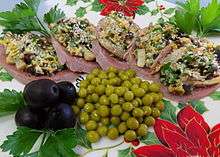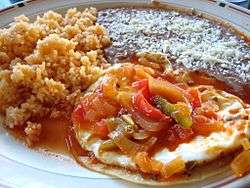Beef tongue

Beef tongue or neat's tongue is the tongue of a cow. Beef tongue is very high in fat, at almost 75% of its calories derived.[1] Some countries, including Canada and specifically the province of Alberta, export large quantities of beef tongue.
The tongues of other animals, notably pigs and lambs, are also eaten, and are very similar to beef tongue.
In some animals, the tongue is reputed to be the tastiest part. For example, Adolf Erik Nordenskiöld found most of the walrus not particularly tasty, but walrus tongue, a delicacy.[2] The whale tongue, too, was viewed as a Lenten delicacy by Roman Catholics in the Middle Ages.[3]
Preparation

Tongue is often seasoned with onion and other spices, and then placed in a pot to boil. After it has cooked the skin is removed. Pickled tongue is often used by the preparer because it is already spiced. If cooked in a sauce, it can then later be reused as a sauce for meatballs or any other food item.
Another way of preparing tongue is to scald it in hot water and remove the skin, then roast the tongue in an oven, using the pan drippings to prepare a gravy.
In cuisines

Beef tongue is used in North America as a major ingredient of tongue toast, an open face sandwich prepared for breakfast, lunch, or dinner and sometimes offered as an hors-d'oeuvre. It is widely used in Mexican cuisine, and often seen in tacos and burritos (lengua).[4] In Puerto Rican cuisine, lengua al caldero, pot roast tongue, and lengua rellena, braised stuffed tongue, are both served with Pique criollo.
In Belgium and France, boiled beef tongue is often prepared with mushrooms in a Madeira sauce but can also be served with a vinaigrette. In Ashkenazi Jewish, Russian and Ukrainian cuisine, boiled tongue is often served with chrain. Beef tongue or veal tongue is also found in classic recipes for Russian Salad. In Austria, Germany and Poland,[5] it is commonly served either with chrain or with horseradish cream sauce. The traditional Berlin / North-German variant adds capers and vinegar to the sauce based on the broth with white roux.
In Japanese cuisine, the dish gyūtan, originating in the city of Sendai, is made of grilled tongue.
Also, tongue is a part of Argentine, Brazilian, Bulgarian (tongue with butter), English, French, Indonesian (semur lidah or beef tongue stew), Italian (typical dish in Piemonte and Genoa), Japanese, Korean (hyeomit gui), Mongolian, Nicaraguan, Persian, Portuguese, Philippine, Romanian, Spanish, and Turkish (as forms of fried, roasted, boiled and eaten cold in a sandwich) cuisine.
See also
References
- ↑ Calories in Beef Tongue
- ↑ Nordenskiöld, Adolf Erik (1882), The Voyage of the Vega Round Asia and Europe: With a Historical Review of Previous Journeys Along the North Coast of the Old World Collection Léo Pariseau, translated by Alexander Leslie, Macmillan and Company, p. 122
- ↑ Roman, Joe (2006), Whale, Reaktion Books, p. 42, ISBN 1861895054
- ↑ Lengua (Beef Tongue)
- ↑ Robert Strybel; Maria Strybel (2005). Polish Heritage Cookery. Hippocrene Books. p. 257. ISBN 9780781811248.


